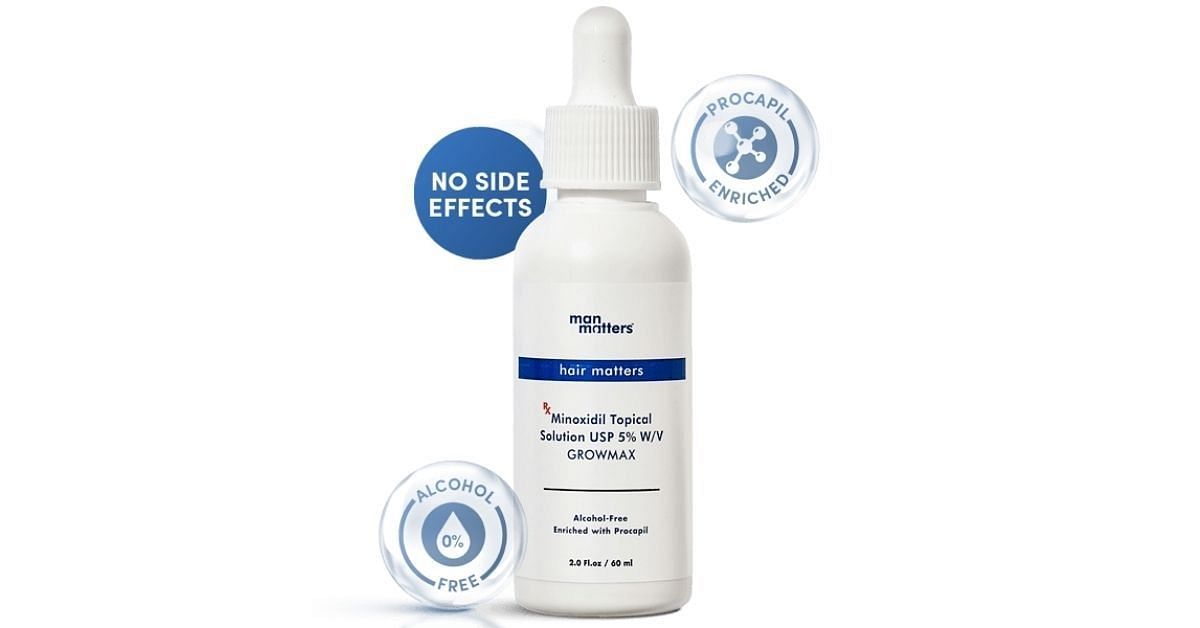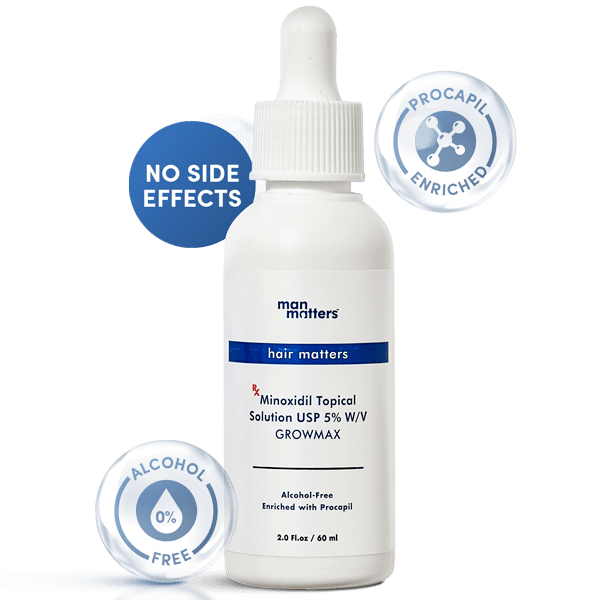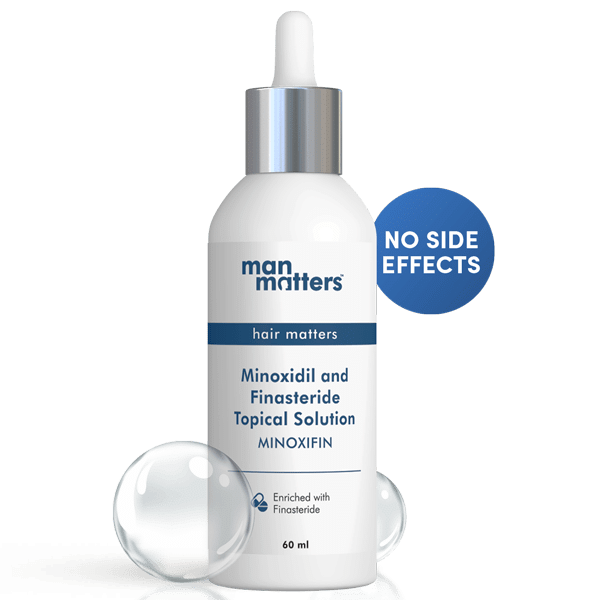Minoxidil Uses, Side Effects, Precautions, FAQs ~ Doctor Backed
Hair loss is an issue that most men face in the present era. Check how minoxidil can benefit your hair fall, how to use it, precautions, side effects, and much more.

The modern lifestyle, food, social life, and workload has greatly impacted many’s health. One such impact is hair loss, a common phenomenon among men. Several over-the-counter products available in the market help deal with the issue, but these may not suit everyone.
Hair products contain different chemical compositions, which may not be ideal for every hair type and texture. Minoxidil works to manage hair loss and baldness. In this write-up, let's know how it works, different minoxidil uses and more.
What is Minoxidil?
Originally designed for managing high blood pressure, minoxidil is a drug prescribed for severe hypertension. Further, this hypertensive medication underwent topical development to promote hair growth.
It is also suitable for assisting in androgenic alopecia and many hair loss conditions. There are two types of minoxidil solution,
- Minoxidil 2%
- Minoxidil 5%
It was in 1986 when the FDA approved the 2% concentration. Minoxidil with a 5% concentration came into the market in 1993. Doctors may prescribe any, depending on a person's hair health and hair loss.
How Does Minoxidil Work?
Minoxidil's topical (directly on the scalp) application helps widen the blood vessel, further improving blood flow.
Further, it enhances the nutrient and oxygen supply to the follicles, helping their growth. However, there isn't an exact mechanism or validation of its working, but it helps the hair follicles shift from the resting phase or telogen to the growth phase or anagen.
Evidence suggests that minoxidil's application helps lengthen the anagen phase, resulting in thicker or longer hair.

Before taking Minoxidil Medication
While using any medicine, it is essential to know whether it will cause any risk or not. One must consider the following things before taking minoxidil for hair:
- Allergies: Talk to your doctor regarding allergies, whether a medicine, dyes, foods, or preservatives. In the case of non-prescribed minoxidil use, check the ingredients properly.
- Medical problems: The presence of any medical issues can impact your health while using it. It includes heart disease and skin issues like burning, irritation, or sunburn on the scalp.
- Other drug usages: Sometimes, using two different medications might cause a reaction. Hence, if you are using any other drug, talk to your doctor. They would either suggest different doses or precautions.
However, one should not use it if you have pheochromocytoma, also known as an adrenal gland tumour. For the safe side, talk to the doctors if you have asthma, migraine headaches, chest pain, kidney disease, etc.
Minoxidil Uses & Benefits
Generally, the most common minoxidil use is for hair growth. One can use it as a liquid or foam at least twice a day or as recommended by the doctor. It helps extend the hair follicles' growing phase.
Hair follicle growth undergoes four phases. Generally, all the follicles aren't at the same growth stage. However, the medication affects typically two stages, viz:
- Anagen phase: It is the growing phase when the hair follicles push out of the roots. With the minoxidil's application, it lengthens the anagen phase.
- Telogen phase: It is the resting period when the growth is complete, but it is not yet ready to fall.
Let's check how minoxidil's application benefits:
1. Minoxidil for Hair Growth
2% concentration of minoxidil and a solution is known to revive the receding hairline. It helps enhance the blood flow, creating an idyllic environment for the hair follicles to grow better.
In the starting phase of using this medicine, one might experience hair shedding. It is because the new hair follicles push out the existing ones.
2. Minoxidil for Hair Loss
Research shows that minoxidil helps awaken the dormant hair follicles. One can use it as a gel, foam, or solution. In the topical application (involving a low drug concentration), the skin absorbs approximately 2% of the medicine. It helps improve hair regrowth rate and thickness.
3. Minoxidil for Beard Growth
Ageing, fungal infections, or autoimmune disorders makes hair sparser. Minoxidil's application fuels up the blood vessels around the follicles. Further, it prompts the protein cell for progressive hair growth. In the entire growth cycle, here is how the minoxidil 5 solution works:
- It activates the first phase of anagen, wherein the protein-based cells in the follicles start developing.
- In the second phase, blood vessels around the hair follicle fuel up the protein cells, allowing progressive growth.
- At the beginning of the catagen phase, the hair grows gradually and pops out of the skin. Further, the oil gland in the skin lubricates it.
- The hair comes out of the follicles in the telogen phase, and a new growth cycle begins.
However, it takes almost a year to complete this cycle.

4. Expanding Blood Vessels
Also known as vasodilation, one of its primary uses is expanding the blood vessels. Expanded blood vessels make the hair follicles feed the hair growth during an anagen phase. It slows down the speed of falling hair out, giving a thicker and filled-out look to the hair.
5. Minoxidil for Women
FDA approves using 2% minoxidil formula for treating female-pattern baldness. It works by prolonging the hair follicle growth phase.
Consistent use may not only slow down hair loss but also stop it. However, pregnant women should avoid it as it may have mild to serious side effects.
Apart from hair-related issues, other uses of minoxidil are:
- Hypertensive heart disease
- Hypertensive retinopathy
- Hypertensive heart and renal disease
- Hypertensive encephalopathy
- Renovascular hypertension
Also Read: Minoxidil: Everything you need to know
How To Use Minoxidil?
Research shows that minoxidil's application initiates and works when you use it consistently.
You may witness that hair in some parts becomes thicker and less prone to male-pattern baldness. However, it is essential to use it correctly for better results.
Here are the steps to use the topical solution:
- It is essential to dry out the hair thoroughly before applying the solution.
- Fill the dropper (available with the solution) with 1 ml of the solution.
- Apply on the patchy or bald areas using a dropper. Part the hair properly so that the solution comes into contact with the scalp.
- Use your fingers to rub the solution along the scalp for better penetration and let it sit for 4-5 hours.
- Lastly, wash your hands properly with soap and lukewarm water.
Steps to apply minoxidil foam:
- Ensure that your hair is dry and clean
- Part your hairs, especially where the hair is thin or has bald patches
- Dispense a half capful of foam through the nozzle onto the fingers
- Gently apply on the parted areas and massage using the fingers
- After applying, let it sit for 4-5 hours for the medication to work.
- Let it dry completely before using any fabric item, like bed linen or clothing. If it gets into the eyes, skin, or sensitive areas, rinse with water as soon as possible to avoid irritation.
Minoxidil Side Effects
Generally, the minoxidil side effects depend on different cases: less prominent, rare, and very rare. Doctors judge the benefits over the side effects before suggesting its dosage. However, a particular body type may face some side effects after using it.
Some less common side effects are:
- Skin rashes or itching
- Scalp dryness
Some rare side effects include:
- Redness on the skin where the lotion is applied
- Facial hair growth
- Burning sensation in the scalp that continues for long
- Acne at the application site
- Soreness and inflammation at the hair roots
In case of heavy absorption of the medication, one might face severe side effects, which includes:
- Dizziness and fainting
- Blurred vision or any change in the vision
- Flushing
- Lightheadedness or headache
- Irregular or fast heartbeat
- Swelling of the face or lower legs or hands or feet
- Numbness or having a tingling sensation in the face, feet, or hands
- An unusual gain in weight
- Tiredness or difficulty in breathing, especially while lying down
Such side effects depend on the dosage, a person's skin type, and the reaction caused due to its usage. Although it may vary from person to person, it is better to consult the doctor if you face such things.
Doctors change the dosage or suggest any precautionary methods while encountering the side effects. They help make sustainable use of medicine for you.

Minoxidil Precautions
Doctors check the progressive result of using the medication. Hence, it is crucial to visit the doctors regularly and portray how you feel or any issues while using the medicine.
Have clear communication regarding any allergies or other drug usage before using minoxidil. It contains some inactive ingredients that can cause allergic reactions. Hence, no sooner you witness such reactions, consult your pharmacist.
The doctor's recommendation and visit are crucial if you develop any of these health issues:
- Scalp diseases including cuts, eczema, or infections
- Kidney or liver disease
- Heart problems like chest pain, heart failure, or heart attack
Take the following precautions while considering its storage:
- Try keeping it away from the flame or fire as it is flammable.
- Keep out of the children's reach.
- Store the medicine at room temperature, away from moisture, heat, and direct sunlight.
Minoxidil Price
Generally, its price differs from one brand to another. However, the average price of different variants of minoxidil are:
- Minoxidil-foam with 5% concentration topical treatment, for a 3-month usage costs around INR 4999/-
- Minoxidil-solution with 2% concentration topical treatment, for a 3-month usage, costs approx INR 4500/-
- 60 g bottle of minoxidil-2% foam for hair regrowth costs around INR 4999/-
However, the cost of minoxidil for facial hair, meant for hair regrowth, costs from INR 400 to INR 1000. Before you purchase any type, check the topical solution’s key ingredients, alcohol content, and growth efficacy.
Minoxidil Dosage
The dose of the medicine varies. One should consider the doctor's recommendation or check the instructions for proper use. The strength of the medicine determines what amount one should use.
The mere concentration of the medicine does not determine the effective results. Effective results depend on the total dose and length of the time you are taking medicine.
The average dose of taking minoxidil for hair growth are:
- Topical foam dosage form:
- Adults: Use half a capful to the exposed scalp twice a day.
- Topical solution dosage form:
- Adults: Apply 1 ml of the solution on the scalp twice a day.
Apply it as soon as possible if you miss any doses. However, skip the missed dose and return to your regular schedule if the next dose is near. Avoid double-dosing unless recommended by the doctor.
Minoxidil VS Finasteride
Finasteride is an oral drug that doctors originally recommended for shrinking an enlarged prostate. Minoxidil is an over-the-counter product available as serums, foam, and shampoos; it originally came as a hypertensive medicine for treating high blood pressure.
Finasteride helps treat female and male-type baldness while lowering DHT levels. As it targets DHT, it does not work on hair loss caused due to other medical issues, chemotherapy, hyperthyroidism, stress, etc.
Minoxidil is a vasodilator that widens the blood vessels for efficient blood flow. Finasteride is more prone to sexual side effects, including decreased sexual desire and semen. However, minoxidil is less prone to sexual side effects. Moreover, one starts recovering within 40 months after stopping the medication.
Peppermint Oil VS Minoxidil
Peppermint oil has 40% menthol, antioxidants in phytochemical, and revitalising properties. The topical application of peppermint oil enhances blood circulation. Generally, dihydrotestosterone reduces blood flow around the follicles, depriving them of essential nutrients. Hence, topical use of menthol prevents hair shrinkage while improving blood flow in the scalp. Peppermint oil is a natural alternative to minoxidil as the latter has mild to severe side effects.
However, minoxidil's application is the most recommended hair loss treatment, wherein the growth is slow but effective.
Summing Up on Minoxidil
Minoxidil is a vasodilator that helps boost the blood flow around the hair follicles. Enhanced blood flow fosters hair growth. However, regularity holds utmost importance.
Missed dosage or suddenly stopping the product may impact the blood flow and nutrient supply to the follicles. It is also important to consult a doctor if you have any medical conditions.
Proper dose, essential precautions, and perfect monitoring of the side effects provide vital benefits.
FAQs
Does Minoxidil Cause Permanent Hair Loss?
No, the minoxidil's application does not cause permanent hair loss. It only generates the anagen phase when you apply it over the scalp.
In other words, the solution tends the hair follicles to undergo a premature growth process before it starts regrowing. The premature growth causes early hair shedding. It is why one witnesses hair loss in the starting two weeks of minoxidil's application.
However, this does not cause permanent hair loss.
What Happens if You Stop Minoxidil?
When you stop taking medicine, it hinders the scalp's blood flow. Reduced blood flow limits the nutrient supply to the hair follicles, causing the hair to shred frequently.
If you stop minoxidil's application, you may gradually lose the regrown hair. Moreover, it may progressively start worsening, returning to the previous situation.
Which Shampoo to Use After Minoxidil?
Ketoconazole based shampoo is ideal to use after minoxidil's application. The shampoo contains antioxidants and anti-inflammatory ingredients that help treat fungal infections, itchy scalp, and dandruff. If you suffer from hair loss or scalp-related issues, it is the best shampoo to use after this medication.
When using at night, wash your hair with the ketoconazole shampoo in the morning. Avoid using ketoconazole shampoo, minoxidil-5%, and zinc pyrithione shampoo together at the same time.
Can You Leave Minoxidil on Overnight?
Yes. For a perfect result of minoxidil's application, it is essential to leave it on for 4-8 hours. Hence, you can keep it on overnight while applying just before bed.
Moreover, when you follow the golden thumb rule, it is best to apply minoxidil-2% or 5% at night. However, make sure your scalp is clean and perfectly dry before using them.
Remember to shampoo your scalp in the morning to avoid irritation or hair loss due to buildup. Leaving the medicine on for more than 8-9 hours causes buildup that causes irritation and an itchy scalp.
Does Minoxidil Regrow Hair?
Yes. Minoxidil's application helps track hair loss and ensures its recovery. In many cases, it even promotes the regrowth of new hair. However, there are pros and cons to using the product.
It is expensive and can cause inconvenience to many people due to its side effects. Consult your dermatologist before starting minoxidil's application, especially if you have any skin sensations.
References
- Poonkiat Suchonwanit, August 2019; Minoxidil and its use in hair disorders: a review - https://www.ncbi.nlm.nih.gov/pmc/articles/PMC6691938/#CIT0016
- Min Wu, October 2016 Differences in reproductive toxicology between alopecia drugs: an analysis on adverse events among female and male cases - https://www.ncbi.nlm.nih.gov/pmc/articles/PMC5347675/
- O Mori, May 1990; The effect of topical minoxidil on hair follicular cycles of rats - https://pubmed.ncbi.nlm.nih.gov/2380431/
- P E Kudlacek, D L Clemens, February 1998; Sulfation of minoxidil by multiple human cytosolic sulfotransferases - https://pubmed.ncbi.nlm.nih.gov/9566733/

